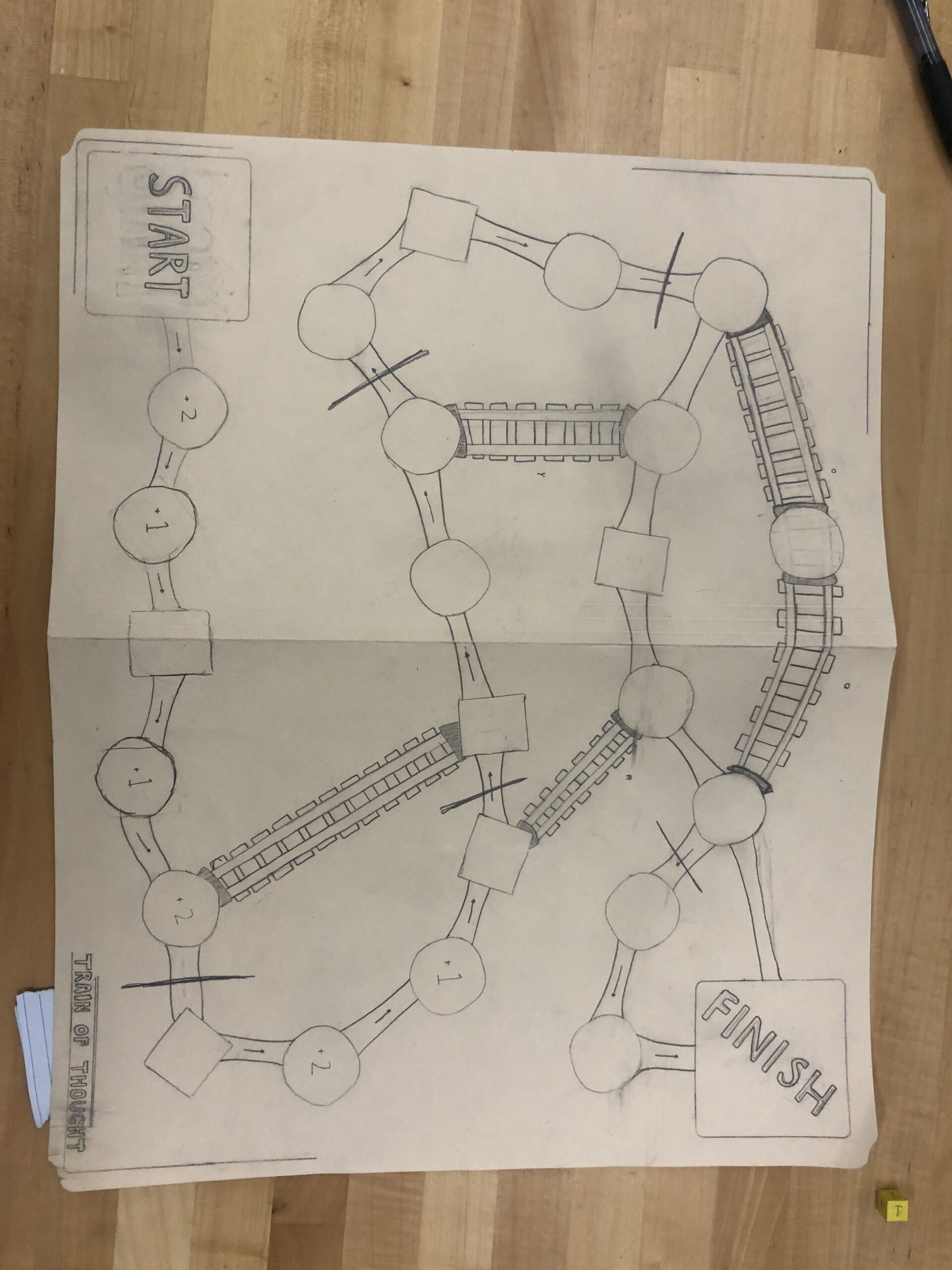Starting from the Bottom
In our game design process, we went through multiple iterations before ending up with our current version. Initially, we were thinking about having a circular track that players would draw cards from (A.1). In this version, we were thinking about an ultimate goal of overcoming an obstacle as a team. Although all players would be working together to accomplish this collective goal, we also were thinking about including a point system to have players concurrently compete against each other. The emphasis of this game was semi-cooperation. At this stage, our mechanic of a “track” led us to loosely have a theme relating to trains, which ultimately continued in our following game versions. Some notes relating to this initial version are seen in (A.2).
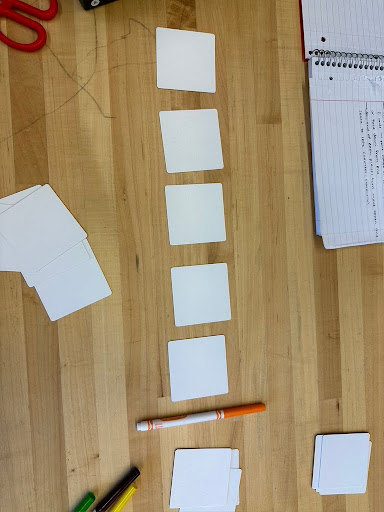
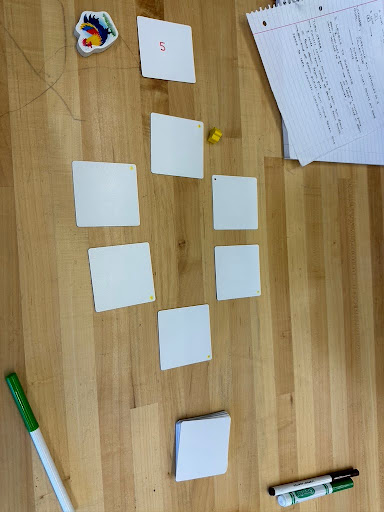
(A.1)
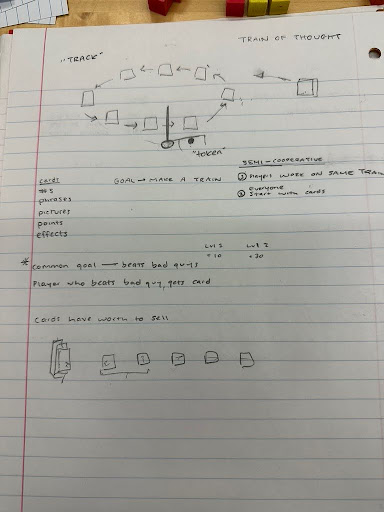
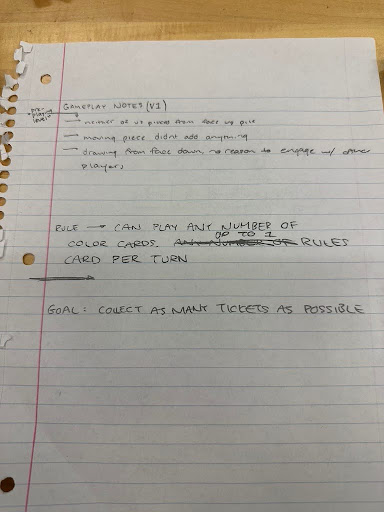
(A.2)
Our next session was several days after the first. We playtested our idea, and discovered the game lacked engagement between players. After a few iterations on the mechanics and rules, we still felt unsure of what additions or changes could help this idea. We took a step back to re-evaluate what part of our idea got us most excited, which was its theme.
Going Theme-First
Specifically, we envisioned a game about trains where people were encouraged to tell travel stories, similar to Ticket to Ride. We initially started with several modes of transport as seen in the bottom index card of (A.3). Over time, our idea shifted to focus on the occasional wackiness of urban subway systems, such as the CTA or the MTA.
We found that being constrained to a theme and designing top-down helped us decide what mechanics and rules to add or change. The card track was scrapped for a board where players can take trains to get to their destination. Tickets were repurposed as a way to get move faster on the board via train instead of being the score directly. To incorporate a social storytelling element, we experimented with some forms of mini-game where players draw a random prompt, tell a story, and are voted on the best story. However, we found that due to the lack of anonymity, players were likely to vote based on who’s winning rather than on the stories themselves. To add anonymity, we went with fill-in-the-blank prompts very similar to Cards Against Humanity where players anonymously play responses before a judge. At this point, we liked that the game felt casual and social, but we were aware that some of the mechanics did not support this affect.
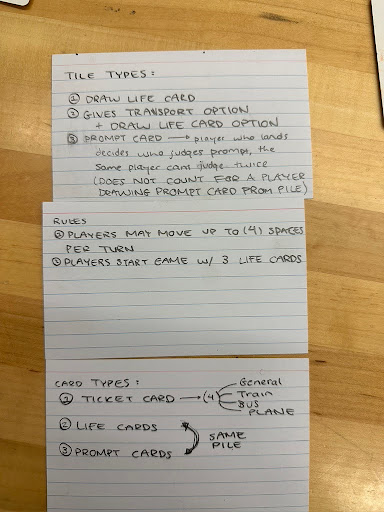
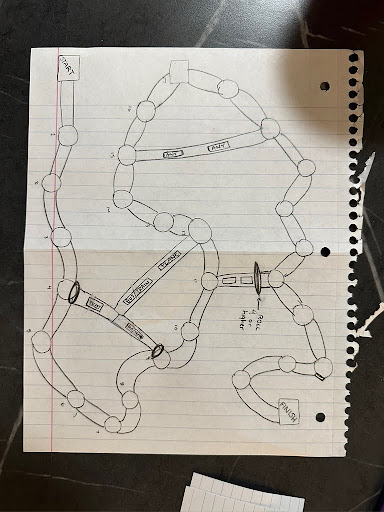
(A.3)
Movement
Ironically, our movement system caused us the most trouble. We started with a standard system where players can move up to a certain number of spaces. Since the goal was to reach the end first, we ended up ignoring the mini-game, which we’re calling a CTA Event, and just walking as much as possible each turn.
We wanted to encourage people to start CTA Events because it was the most engaging part of the game. One way we tried this was by tying movement to dice rolls like in Clue, with some dice faces causing a CTA Event immediately. We playtested and found that this really helped the game’s pacing and increased the amount of time the CTA Event was played. Overall, this playtest was much more fun than the one before. However, the outcome of the game felt like it had very little tie to skill, which we weren’t completely opposed to for a casual game, but we still wanted to test some other movement systems to see how they felt.
In our third iteration, we tied your max movement amount to the number of cards in your hand. The idea behind this was that players may go out of their way to start a CTA Event because it would force players to use the cards in their hand, leading to them being slower. As well as that idea worked in our heads, it immediately fell apart in the first few rounds of testing. Players were encouraged to hoard their cards and avoid using them. The incentive of making others use their cards didn’t feel very impactful for the players who were winning, but for players who were stuck at one card, felt very bad. This iteration led to low engagement with CTA Events, but did have an aspect of spatial strategy, since you could choose to step on a tile that gives you more cards or makes other players lose cards, that we enjoyed.
For our most recent iteration, we leaned more towards the casual nature of dice rolling since this was the iteration we enjoyed the most. Instead of dice rolling, we made movement automatic. We decided to do this because the decision is out of the player’s hands either way, so we might as well make the process of movement quick, so that people can get to the CTA Events faster. Additionally, a CTA Event was automatically started at the start of each turn, and the results changed movement. The player with the best card moves one extra space while the player with the worst moves one less. This ties the movement to the CTA Events, which feel skill-based. So we felt that the outcome was related to player skill, even though the skill was more about guessing which card a judge would like most rather than spatial strategy skills. This is our favorite iteration because it clearly places emphasis on CTA Events while still feeling like players have control over the outcome.
Still, there are some aspects we recognize could benefit from further iterations. For example, we would like to incorporate some spatial strategy into the game, which we may accomplish by causing CTA Events to have effects on the board state (causing train delays, reroutes, etc.) rather than affecting the players directly. Although we couldn’t playtest this sufficiently, we expect ties to be common and we still have tile effects that allow players to draw cards, which may feel inconsequential given the mostly automatic movement. If we were to continue this project, we would start by addressing these points.
Update: 1/24
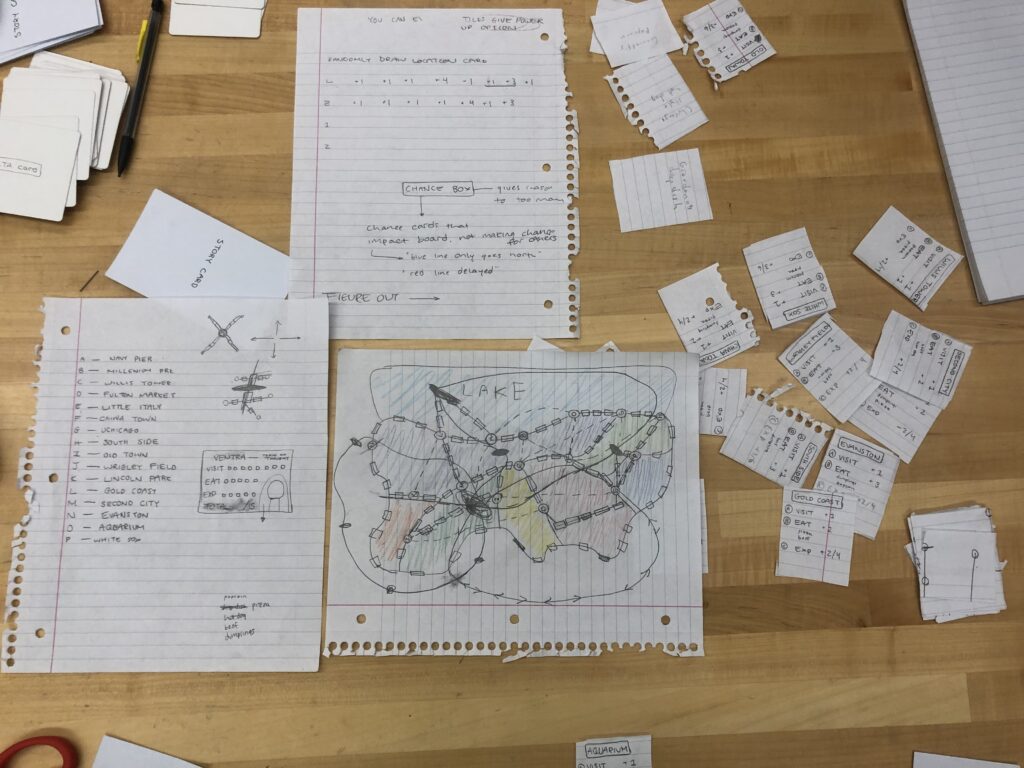
I misunderstood the assignment, turns out we were to continue this project for another week. This was great news for us as there were many changes we wanted to experiment with. Instead of addressing our previous concerns directly, we started by analyzing our feedback.
Overall, there was a very positive reception to reading out prompts with responses and using train tracks as shortcuts to get around the board. For the former, people usually found the combinations funny, leading to the social engagement we were hoping for. For the latter, people told us that the tracks give players who are behind a chance to catch up. We even received a suggestion to add another kind of track that goes backwards, which to us was an indication that people enjoyed engaging with the track system and the consequences it had for movement.
From these observations, we felt the two clearest directions to start were to expand on the track system or on the card game. Since we also received feedback that the board felt unnecessary and disconnected from the cards, we decided to flesh out the board through expanding the track system first.
To incorporate the suggestion of drawing inspiration from Chicago and the CTA more directly, we designed some elements of the tracks with a top-down approach. We added three different train lines and made it so players can stay on a train in between turns to keep moving one stop at a time. While this change was initially meant to make tracks slightly more realistic, we noticed that it added decisions, such as saving a train ticket to stay on the train but consequently limiting your movement, so we kept it in our future iterations.
Our changes to the track system were best used under several rule changes. It worked best when the board was non-linear, so people could take the train in both directions, get off and back on, and other types of movement that wouldn’t be possible with our current board. This time around, movement felt more intuitive to implement. We knew we wanted it to encourage people to take the train, so we made it relatively slow, but multi-directional so players had many options.
Since the board was no longer linear, the goal of the game also had to change. We had a few iterations where the goal was to get to the center, but we found that this led to very deterministic gameplay. To add decisions in how players got to the center, we added scoring rules where players got more points for visiting locations around the map in addition to reaching the center first. We found that this encouraged us to plan routes involving the train system more often.
The last major consideration we made was how players should be able to get points. Initially, we had to is so you can choose from several (2 at this point) minigames when visiting a location, one of them being the card game from our class prototype, and the other being a set collection game where you draw cards and want to visit the location that gives you points for having those cards. As we playtested, we liked the second minigame more because it felt less self-contained. We think there are ways to incorporate the card game into this game, but we didn’t have enough time to test all our ideas out, so it’s left out of the final iteration in favor for the set collection game instead. We chose this one mainly because it was easier to encourage going to certain locations with a matching mechanic. As going to different locations encourages use of the train mechanic, this felt best for our game.
However, we still wanted to implement the feedback that CTA cards being drawn through board tiles and the suggestion to make them dual-purpose. So, memory cards, used in the set collection game, are drawn by going to a location, which are certain places on the map. They can also be spent to get train tickets, making it so cards that aren’t helpful for the set you want don’t feel completely useless.
With our current iteration, we are pleased with our expansion of the train system, but are most disappointed about the exclusion of the storytelling elements that players enjoyed from the card game in our class prototype. We tried to implement the spirit of CTA stories in the flavor text of some cards, but it lacks interactivity. If (?) we were to continue this project, we would start by refining the current mechanics, such as making the decision of “which card should I spend on a train ticket” more interesting. After that, we would test several ideas we have for implementing the interactive and subway story themed, storytelling elements of our class prototype.
